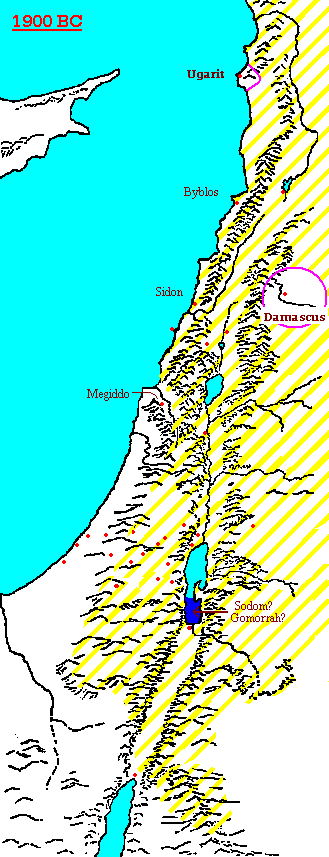Prepare Ye the Way
1900 - 1800 BC, the Holy Land
1900 - 1800 BC, the Holy Land
 The four northern cities of the plain survived their sack by the Great Kings only to be utterly destroyed in a great catastrophe.
The four northern cities of the plain survived their sack by the Great Kings only to be utterly destroyed in a great catastrophe.
There is evidence indicating the water level in the Dead Sea is higher than it was in Abrahamís time. The southern section of the sea is very shallow - less than 30 feet. This is earthquake country, an extension of the great rift system of Africa. If the Plain of Siddim was once dry land in this area, it could easily have been dropped by earthquake below the level of the Dead Sea in one cataclysmic disaster which Zoar alone survived.
Such an event is far from impossible. We know that the towns of the Transjordan were quite abruptly abandoned before 1800 BC and the later inhabitants of the area were nomads. Perhaps a change in the water table at that time, reflecting a general disturbance, upset a delicate ecological balance. Or perhaps a new pastoral Amorite people, less concerned with careful watering and tending of the soil, had the same effect.
At any rate, Lot and his daughters escaped the destruction. His sons by these daughters were Moab and Ammon. The Israelites recognized a close relationship to the Moabites and Ammonites, who had a language and many customs related to those of the Israelites.
The Israelites also acknowledged kinship to the Semitic tribes of Arabia. Abrahamís first son, Ishmael, by the servant Hagar, was sent away to leave a clear heritage for his second son Isaac. The Mohammadans over 2,000 years later traced their lineaage back through Ishmael to Abraham.
Isaac had twin sons, Jacob and Esau, and again the inheritance went to only one (Jacob) and Esau was left with nothing. He prospered, however, in the Sinai region of Edom. The later Israelites recognized their relationship to the Edomites, too, although there was ill feeling between these two peoples.
Posted by John  Read more
Read more  Comments (15)
Comments (15) ![]() 17.01.
17.01.